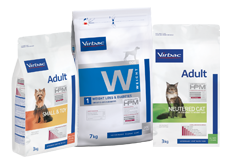ADVANCED KIDNEY & JOINT
מזון כליות ומפרקים שלב 3 - יתרונות בריאותיים ומאפיינים
תומך בכליות בחתולים הסובלים ממחלת כליות כרונית בשלב מתקדם, עם או בלי בעיות מפרקים
רמת חלבונים מופחתת
רמת זרחן נמוכה מאוד
טעימות גבוהה מאוד, עשיר ומזין, למניעת חסרים תזונתיים
חלבונים באיכות גבוהה, בעיקר חלבון מהחי
תכולה גבוהה של חומצות שומן אומגה 3
Available sizes:
- 0,4 kg
- 1,5 kg
- 3 kg
Dogs and cats are carnivores regardless of their health status. The VETERINARY HPM Clinical Diets are based on a formulation high in protein and low in carbohydrate (HP-LC), of which an average of 90% of the protein is of animal origin.
הרכב: חלבון חזיר מיובש, אורז, שומן מן החי, עמילן תפוחי אדמה, אפונה, חלבון חזיר ועוף שעבר הידרוליזה, מינרלים, שמן דגים, עיסת סלק, ליגנוצלולוזה, שמרי בירה, חלבון דגים שעבר הידרוליזה, סיבי פסיליום, פרוקטו-אוליגוסכרידים, ממברנת קליפת ביצה, סרטנים שעברו הידרוליזה (מקור לכיטוזן), כונדרויטין סולפט, לקטובצילוס אצידופילוס
מזון HPM וטרינרי לא מכיל חומרי טעם או צבע מלאכותיים
| אנליזה | |
| (% במזון מוכן לאכילה) | |
| לחות | 5.5 % |
| חלבון | 30 % |
| יחס בין חלבון מהחי לחלבון צמחי | 86/14 |
| שומן | 21 % |
| מינרלים | 7 % |
| סיבים גולמיים | 3.5 % |
| NFE * | 33 % |
| עמילן | 28 % |
| סידן | 1 % |
| זרחן | 0.5 % |
| נתרן | 0.4 % |
| אשלגן | 0.8 % |
| חומצות שומן אומגה 6 | 3.2 % |
| חומצות שומן אומגה 3 | 1.5 |
| DHA | 0.4 |
| *Nitrogen Free Extract |
מומלץ לפעול על פי טבלת המינונים ולספק מים טריים לשתיה
| משקל גוף (ק"ג) | מנה יומית (גר'/יום) | |
|---|---|---|
| נורמלי * | משקל חסר | |
| 2 | 20 | 25 |
| 3 | 30 | 35 |
| 4 | 40 | 50 |
| 5 | 50 | 60 |
| 6 | 60 | 70 |
| 7 | 70 | 85 |
| 8 | 80 | 100 |
| 9 | 90 | 110 |
| 10 | 100 | 120 |
|
*Normal : senior neutered indoor cat with optimal bodyweight |
||
- Can I feed my kitten with a vegetarian diet?
The cat is a strict carnivore, which means that certain nutrients it needs cannot be provided by a plant-based diet. Such diets can cause major nutritional deficiencies with serious consequences on health. For this reason, a kitten should never be fed a vegetarian diet.
- Can I feed my puppy with a vegetarian diet?
The dog is a carnivore, which means that certain nutrients he needs cannot be provided by a plant-based diet. Such diets can cause major nutritional deficiencies with serious consequences on health. For this reason, a puppy should never be fed a vegetarian diet.
- How can I see if my puppy grows well?
In order to protect the puppy’s health and to prevent early obesity development, a close attention must be paid to the growth curve. More information
To control the puppy’s rate of growth, it is important to carefully monitor his weight curve (page à venir ultérieurement) especially during the most rapid growth period. Weighing your puppy every 2 weeks is the best way to control the situation.
![growth_dog_infographic.png]()
If a large breed puppy becomes too heavy to be picked up on the scale, don’t hesitate to go and weigh the puppy at a veterinary clinic equipped with a platform scale available to clients.
Each time the puppy’s BW is measured, it will be noted on a growth chart. Veterinarians and breed clubs can provide typical curves for different breeds; these references will help you to evaluate your puppy's growth. Your veterinarian can also help you interpret your puppy's growth curve. For example, if the puppy is gaining weight too fast, your vet can adjust the daily feeding ration or advise a new diet that respects the growth requirements while limiting the caloric intake.
- How do I change the diet of my kitten from my current diet to the new VETERINARY HPM® growth program?
At weaning, your kitten must progressively get used to solid food instead of mother’s milk. You can add some warm water to the kibbles at the beginning.
If you change from another dry food to VETERINARY HPM®, to help your kitten's digestive system adapt successfully to the new food, we recommend that you introduce VETERINARY HPM® gradually over a period of 5 to 7 days
![diet_infographic.png]()






